Potawatomi vs Lumbee Community Comparison
COMPARE
Potawatomi
Lumbee
Social Comparison
Social Comparison
Potawatomi
Lumbee
3,223
SOCIAL INDEX
29.8/ 100
SOCIAL RATING
227th/ 347
SOCIAL RANK
2,002
SOCIAL INDEX
17.6/ 100
SOCIAL RATING
276th/ 347
SOCIAL RANK
Lumbee Integration in Potawatomi Communities
The statistical analysis conducted on geographies consisting of 47,707,767 people shows a mild positive correlation between the proportion of Lumbee within Potawatomi communities in the United States with a correlation coefficient (R) of 0.379. On average, for every 1% (one percent) increase in Potawatomi within a typical geography, there is an increase of 0.216% in Lumbee. To illustrate, in a geography comprising of 100,000 individuals, a rise of 1,000 Potawatomi corresponds to an increase of 215.8 Lumbee.
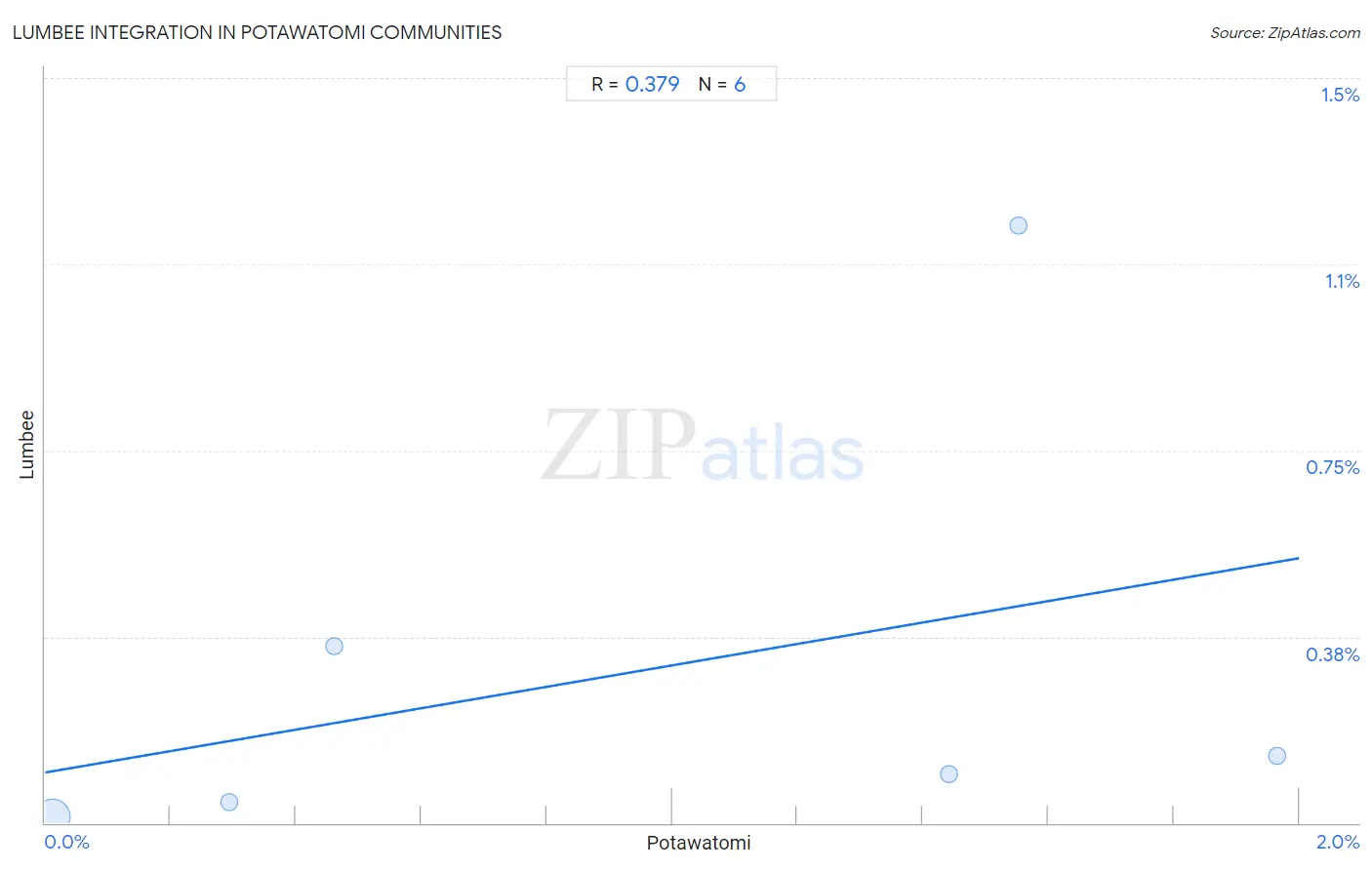
Potawatomi vs Lumbee Income
When considering income, the most significant differences between Potawatomi and Lumbee communities in the United States are seen in householder income ages 25 - 44 years ($81,774 compared to $60,305, a difference of 35.6%), householder income under 25 years ($46,462 compared to $34,584, a difference of 34.4%), and householder income over 65 years ($54,212 compared to $40,550, a difference of 33.7%). Conversely, both communities are more comparable in terms of median female earnings ($34,739 compared to $32,500, a difference of 6.9%), median earnings ($41,288 compared to $36,876, a difference of 12.0%), and median male earnings ($48,768 compared to $41,715, a difference of 16.9%).

| Income Metric | Potawatomi | Lumbee |
| Per Capita Income | Tragic $38,046 | Tragic $29,845 |
| Median Family Income | Tragic $88,265 | Tragic $68,679 |
| Median Household Income | Tragic $72,576 | Tragic $54,644 |
| Median Earnings | Tragic $41,288 | Tragic $36,876 |
| Median Male Earnings | Tragic $48,768 | Tragic $41,715 |
| Median Female Earnings | Tragic $34,739 | Tragic $32,500 |
| Householder Age | Under 25 years | Tragic $46,462 | Tragic $34,584 |
| Householder Age | 25 - 44 years | Tragic $81,774 | Tragic $60,305 |
| Householder Age | 45 - 64 years | Tragic $84,613 | Tragic $65,113 |
| Householder Age | Over 65 years | Tragic $54,212 | Tragic $40,550 |
| Wage/Income Gap | Tragic 27.7% | Exceptional 21.3% |
Potawatomi vs Lumbee Poverty
When considering poverty, the most significant differences between Potawatomi and Lumbee communities in the United States are seen in receiving food stamps (12.5% compared to 22.9%, a difference of 83.8%), seniors poverty over the age of 65 (10.8% compared to 18.1%, a difference of 67.7%), and family poverty (10.2% compared to 17.0%, a difference of 66.0%). Conversely, both communities are more comparable in terms of single mother poverty (34.1% compared to 43.2%, a difference of 26.7%), single female poverty (25.4% compared to 33.0%, a difference of 30.1%), and female poverty among 18-24 year olds (23.7% compared to 31.1%, a difference of 31.1%).
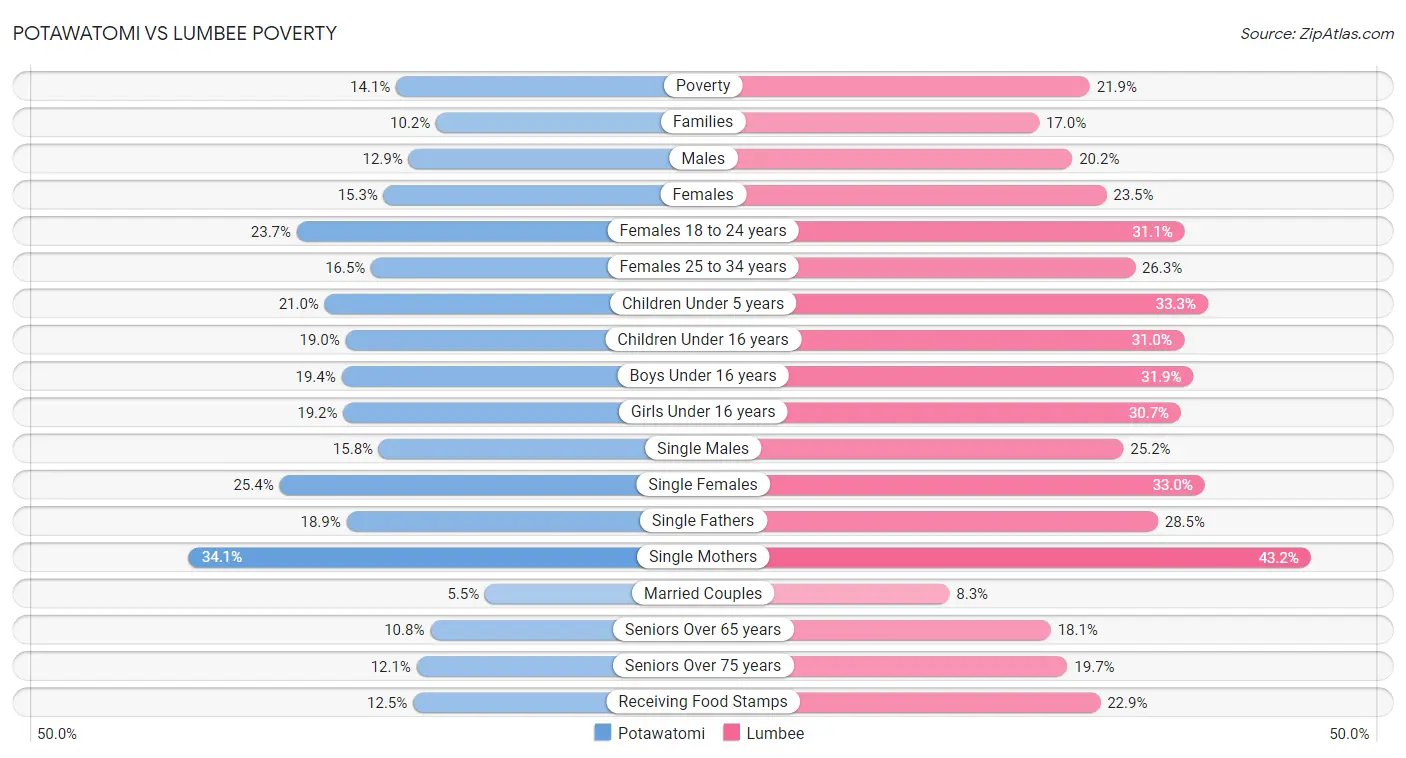
| Poverty Metric | Potawatomi | Lumbee |
| Poverty | Tragic 14.1% | Tragic 21.9% |
| Families | Tragic 10.2% | Tragic 17.0% |
| Males | Tragic 12.9% | Tragic 20.2% |
| Females | Tragic 15.3% | Tragic 23.5% |
| Females 18 to 24 years | Tragic 23.7% | Tragic 31.1% |
| Females 25 to 34 years | Tragic 16.5% | Tragic 26.3% |
| Children Under 5 years | Tragic 21.0% | Tragic 33.3% |
| Children Under 16 years | Tragic 19.0% | Tragic 31.0% |
| Boys Under 16 years | Tragic 19.4% | Tragic 31.9% |
| Girls Under 16 years | Tragic 19.2% | Tragic 30.7% |
| Single Males | Tragic 15.8% | Tragic 25.2% |
| Single Females | Tragic 25.4% | Tragic 33.0% |
| Single Fathers | Tragic 18.9% | Tragic 28.5% |
| Single Mothers | Tragic 34.1% | Tragic 43.2% |
| Married Couples | Poor 5.5% | Tragic 8.3% |
| Seniors Over 65 years | Good 10.8% | Tragic 18.1% |
| Seniors Over 75 years | Average 12.1% | Tragic 19.7% |
| Receiving Food Stamps | Poor 12.5% | Tragic 22.9% |
Potawatomi vs Lumbee Unemployment
When considering unemployment, the most significant differences between Potawatomi and Lumbee communities in the United States are seen in unemployment among seniors over 75 years (7.8% compared to 13.5%, a difference of 72.1%), unemployment among ages 25 to 29 years (7.1% compared to 11.2%, a difference of 58.6%), and unemployment among women with children under 6 years (9.6% compared to 13.8%, a difference of 44.0%). Conversely, both communities are more comparable in terms of unemployment among ages 45 to 54 years (4.7% compared to 4.6%, a difference of 0.59%), unemployment among ages 55 to 59 years (4.8% compared to 4.9%, a difference of 1.8%), and unemployment among ages 35 to 44 years (5.0% compared to 5.4%, a difference of 7.8%).
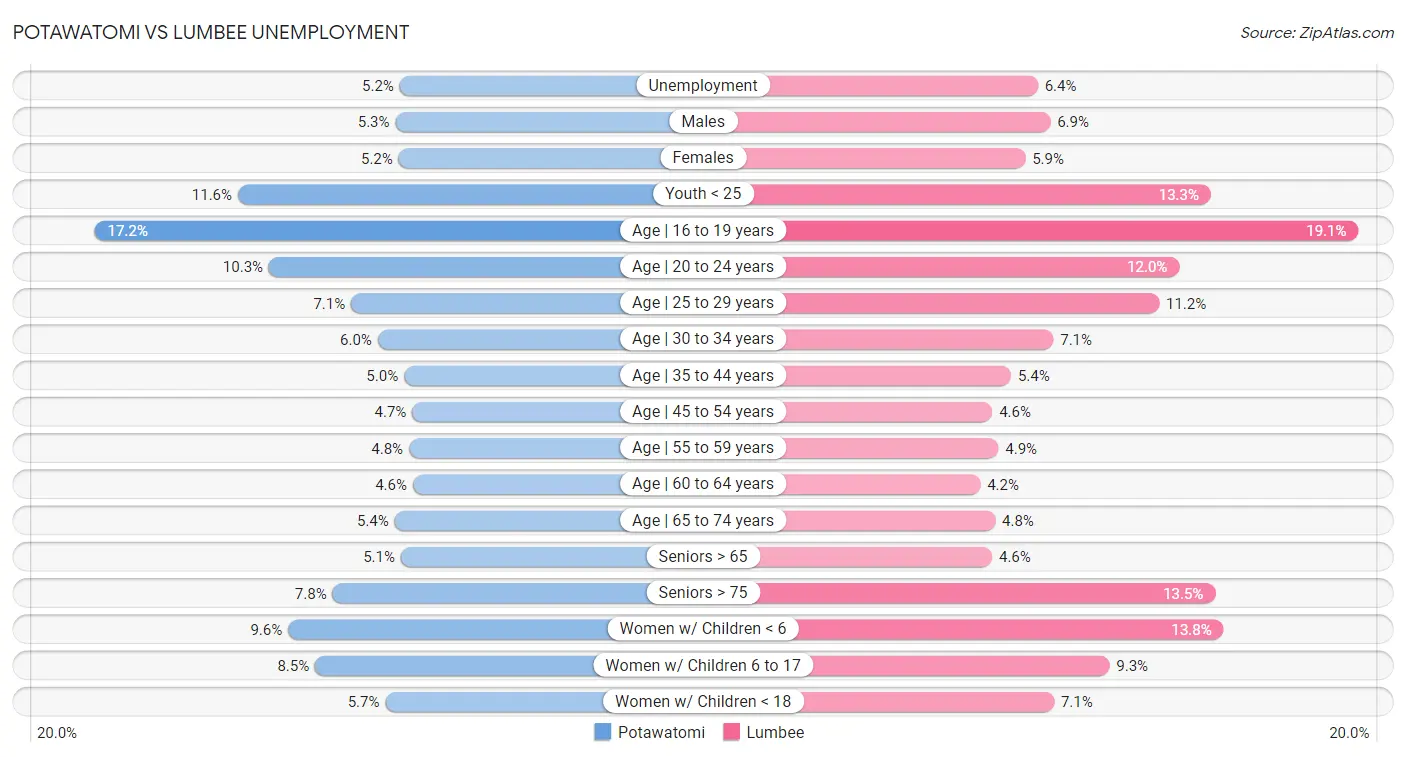
| Unemployment Metric | Potawatomi | Lumbee |
| Unemployment | Good 5.2% | Tragic 6.4% |
| Males | Fair 5.3% | Tragic 6.9% |
| Females | Good 5.2% | Tragic 5.9% |
| Youth < 25 | Average 11.6% | Tragic 13.3% |
| Age | 16 to 19 years | Excellent 17.2% | Tragic 19.1% |
| Age | 20 to 24 years | Average 10.3% | Tragic 12.0% |
| Age | 25 to 29 years | Tragic 7.1% | Tragic 11.2% |
| Age | 30 to 34 years | Tragic 6.0% | Tragic 7.1% |
| Age | 35 to 44 years | Tragic 5.0% | Tragic 5.4% |
| Age | 45 to 54 years | Tragic 4.7% | Tragic 4.6% |
| Age | 55 to 59 years | Good 4.8% | Fair 4.9% |
| Age | 60 to 64 years | Exceptional 4.6% | Exceptional 4.2% |
| Age | 65 to 74 years | Average 5.4% | Exceptional 4.8% |
| Seniors > 65 | Good 5.1% | Exceptional 4.6% |
| Seniors > 75 | Exceptional 7.8% | Tragic 13.5% |
| Women w/ Children < 6 | Tragic 9.6% | Tragic 13.8% |
| Women w/ Children 6 to 17 | Exceptional 8.5% | Tragic 9.3% |
| Women w/ Children < 18 | Tragic 5.7% | Tragic 7.1% |
Potawatomi vs Lumbee Labor Participation
When considering labor participation, the most significant differences between Potawatomi and Lumbee communities in the United States are seen in in labor force | age 16-19 (40.0% compared to 31.0%, a difference of 29.3%), in labor force | age 20-24 (76.2% compared to 65.5%, a difference of 16.3%), and in labor force | age > 16 (62.8% compared to 56.8%, a difference of 10.7%). Conversely, both communities are more comparable in terms of in labor force | age 45-54 (80.0% compared to 75.6%, a difference of 5.8%), in labor force | age 25-29 (82.9% compared to 78.3%, a difference of 5.9%), and in labor force | age 30-34 (82.8% compared to 77.3%, a difference of 7.1%).

| Labor Participation Metric | Potawatomi | Lumbee |
| In Labor Force | Age > 16 | Tragic 62.8% | Tragic 56.8% |
| In Labor Force | Age 20-64 | Tragic 77.2% | Tragic 70.6% |
| In Labor Force | Age 16-19 | Exceptional 40.0% | Tragic 31.0% |
| In Labor Force | Age 20-24 | Exceptional 76.2% | Tragic 65.5% |
| In Labor Force | Age 25-29 | Tragic 82.9% | Tragic 78.3% |
| In Labor Force | Age 30-34 | Tragic 82.8% | Tragic 77.3% |
| In Labor Force | Age 35-44 | Tragic 82.7% | Tragic 77.0% |
| In Labor Force | Age 45-54 | Tragic 80.0% | Tragic 75.6% |
Potawatomi vs Lumbee Family Structure
When considering family structure, the most significant differences between Potawatomi and Lumbee communities in the United States are seen in single mother households (6.6% compared to 9.1%, a difference of 37.8%), births to unmarried women (36.2% compared to 48.2%, a difference of 33.0%), and currently married (46.5% compared to 39.8%, a difference of 16.7%). Conversely, both communities are more comparable in terms of family households (63.3% compared to 63.1%, a difference of 0.39%), family households with children (26.9% compared to 26.3%, a difference of 2.2%), and average family size (3.16 compared to 3.32, a difference of 4.9%).

| Family Structure Metric | Potawatomi | Lumbee |
| Family Households | Tragic 63.3% | Tragic 63.1% |
| Family Households with Children | Tragic 26.9% | Tragic 26.3% |
| Married-couple Households | Poor 45.7% | Tragic 39.6% |
| Average Family Size | Tragic 3.16 | Exceptional 3.32 |
| Single Father Households | Tragic 2.5% | Tragic 2.8% |
| Single Mother Households | Poor 6.6% | Tragic 9.1% |
| Currently Married | Average 46.5% | Tragic 39.8% |
| Divorced or Separated | Tragic 13.5% | Tragic 12.7% |
| Births to Unmarried Women | Tragic 36.2% | Tragic 48.2% |
Potawatomi vs Lumbee Vehicle Availability
When considering vehicle availability, the most significant differences between Potawatomi and Lumbee communities in the United States are seen in 4 or more vehicles in household (7.3% compared to 8.8%, a difference of 20.7%), no vehicles in household (8.8% compared to 10.3%, a difference of 16.9%), and 3 or more vehicles in household (21.9% compared to 23.1%, a difference of 5.9%). Conversely, both communities are more comparable in terms of 1 or more vehicles in household (91.3% compared to 89.7%, a difference of 1.7%), 2 or more vehicles in household (58.0% compared to 55.9%, a difference of 3.7%), and 3 or more vehicles in household (21.9% compared to 23.1%, a difference of 5.9%).

| Vehicle Availability Metric | Potawatomi | Lumbee |
| No Vehicles Available | Exceptional 8.8% | Average 10.3% |
| 1+ Vehicles Available | Exceptional 91.3% | Average 89.7% |
| 2+ Vehicles Available | Exceptional 58.0% | Good 55.9% |
| 3+ Vehicles Available | Exceptional 21.9% | Exceptional 23.1% |
| 4+ Vehicles Available | Exceptional 7.3% | Exceptional 8.8% |
Potawatomi vs Lumbee Education Level
When considering education level, the most significant differences between Potawatomi and Lumbee communities in the United States are seen in professional degree (3.6% compared to 2.5%, a difference of 44.6%), doctorate degree (1.6% compared to 1.1%, a difference of 43.3%), and master's degree (12.1% compared to 9.3%, a difference of 30.2%). Conversely, both communities are more comparable in terms of 6th grade (97.6% compared to 97.6%, a difference of 0.010%), 5th grade (97.8% compared to 97.8%, a difference of 0.040%), and 4th grade (97.9% compared to 98.0%, a difference of 0.090%).
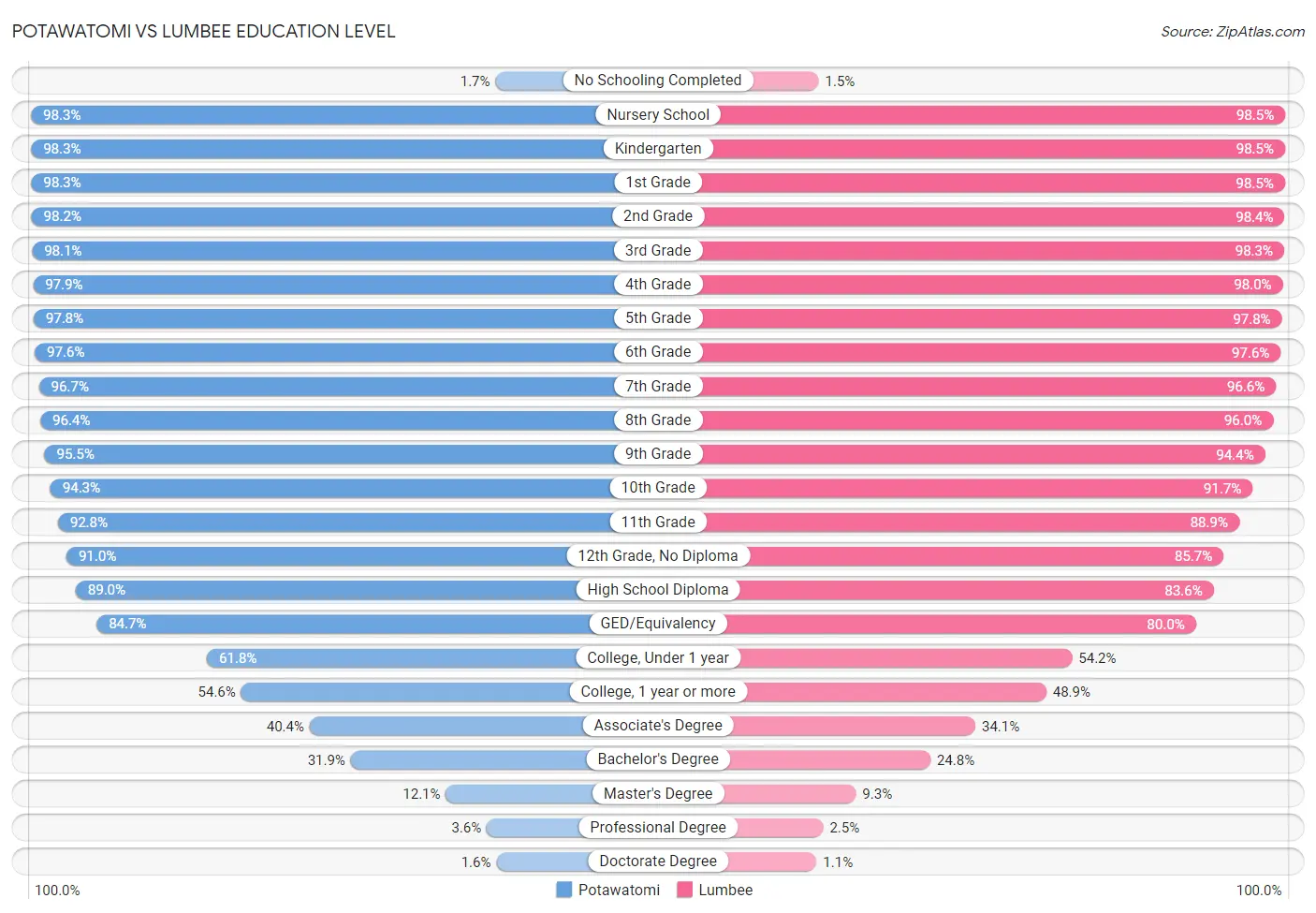
| Education Level Metric | Potawatomi | Lumbee |
| No Schooling Completed | Exceptional 1.7% | Exceptional 1.5% |
| Nursery School | Exceptional 98.3% | Exceptional 98.5% |
| Kindergarten | Exceptional 98.3% | Exceptional 98.5% |
| 1st Grade | Exceptional 98.3% | Exceptional 98.5% |
| 2nd Grade | Exceptional 98.2% | Exceptional 98.4% |
| 3rd Grade | Exceptional 98.1% | Exceptional 98.3% |
| 4th Grade | Exceptional 97.9% | Exceptional 98.0% |
| 5th Grade | Exceptional 97.8% | Exceptional 97.8% |
| 6th Grade | Exceptional 97.6% | Exceptional 97.6% |
| 7th Grade | Exceptional 96.7% | Exceptional 96.6% |
| 8th Grade | Exceptional 96.4% | Excellent 96.0% |
| 9th Grade | Exceptional 95.5% | Tragic 94.4% |
| 10th Grade | Exceptional 94.3% | Tragic 91.7% |
| 11th Grade | Good 92.8% | Tragic 88.9% |
| 12th Grade, No Diploma | Fair 91.0% | Tragic 85.7% |
| High School Diploma | Average 89.0% | Tragic 83.6% |
| GED/Equivalency | Tragic 84.7% | Tragic 80.0% |
| College, Under 1 year | Tragic 61.8% | Tragic 54.2% |
| College, 1 year or more | Tragic 54.6% | Tragic 48.9% |
| Associate's Degree | Tragic 40.4% | Tragic 34.1% |
| Bachelor's Degree | Tragic 31.9% | Tragic 24.8% |
| Master's Degree | Tragic 12.1% | Tragic 9.3% |
| Professional Degree | Tragic 3.6% | Tragic 2.5% |
| Doctorate Degree | Tragic 1.6% | Tragic 1.1% |
Potawatomi vs Lumbee Disability
When considering disability, the most significant differences between Potawatomi and Lumbee communities in the United States are seen in ambulatory disability (7.3% compared to 9.5%, a difference of 30.3%), vision disability (2.6% compared to 3.4%, a difference of 27.8%), and disability age 65 to 74 (27.0% compared to 32.7%, a difference of 21.1%). Conversely, both communities are more comparable in terms of hearing disability (4.1% compared to 4.1%, a difference of 0.29%), disability age under 5 (1.4% compared to 1.3%, a difference of 1.3%), and disability age 5 to 17 (6.5% compared to 6.2%, a difference of 4.6%).
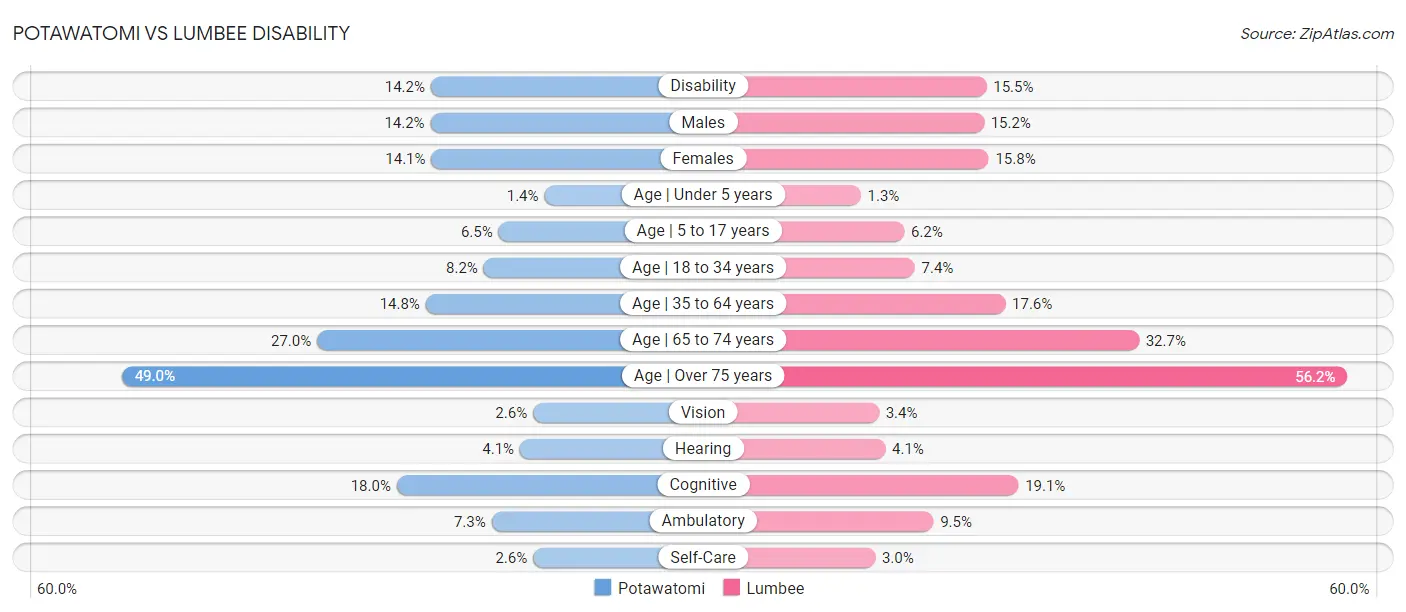
| Disability Metric | Potawatomi | Lumbee |
| Disability | Tragic 14.2% | Tragic 15.5% |
| Males | Tragic 14.2% | Tragic 15.2% |
| Females | Tragic 14.1% | Tragic 15.8% |
| Age | Under 5 years | Tragic 1.4% | Tragic 1.3% |
| Age | 5 to 17 years | Tragic 6.5% | Tragic 6.2% |
| Age | 18 to 34 years | Tragic 8.2% | Tragic 7.4% |
| Age | 35 to 64 years | Tragic 14.8% | Tragic 17.6% |
| Age | 65 to 74 years | Tragic 27.0% | Tragic 32.7% |
| Age | Over 75 years | Tragic 49.0% | Tragic 56.2% |
| Vision | Tragic 2.6% | Tragic 3.4% |
| Hearing | Tragic 4.1% | Tragic 4.1% |
| Cognitive | Tragic 18.0% | Tragic 19.1% |
| Ambulatory | Tragic 7.3% | Tragic 9.5% |
| Self-Care | Tragic 2.6% | Tragic 3.0% |